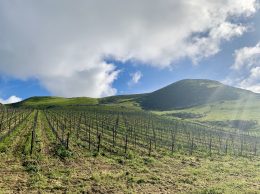New AVAs put Paso in wine industry big leagues
IN THIS ARTICLE
- Agribusiness Topic
- Marissa Wenzke Author
By Marissa Wenzke Friday, October 24th, 2014
On the heels of a top national ranking from Wine Enthusiast Magazine, Paso Robles Wine Country is rolling out an expanded set of sub-brands to put it on equal footing with Napa and Sonoma counties.
The wine region is being divided into 11 new American Viticultural Areas, or AVAs, which means each of these separate regions will have a different name that will appear on wine produced in the area. The Paso Robles name will also appear on bottles, in line with a conjunctive labelling law also used by the Napa Valley region.
“The Paso Robles label will always be as, or more, prominent than the label for the ‘sub-AVA,’ ” said Chris Toronto, communications director for the Paso Robles Wine Country Alliance.
The region has 200 wineries and 32,000 vineyard acres, and wine grapes are the highest-grossing crop in San Luis Obispo County, bringing in an estimated $220.36 million in 2013.
Last year, Wine Enthusiast Magazine named Paso Robles Wine Region of the Year and many wines from the area have been recognized by outlets such as Wine Spectator magazine and the San Francisco Chronicle.
Now the up-and-coming region will divide itself into individual, more specific regions—which include names such as San Miguel, Santa Margarita Ranch and El Pomar—matching similar moves in Napa, Sonoma and Santa Barbara counties. Given more specific definitions for the wine that comes out of Paso Robles, the area can bring even more attention to this blooming industry, said Steve Lohr, chairman and CEO of J. Lohr Winery in Paso Robles.
“Certainly, if you take a look at what’s happened in Napa Valley over the years and how they’ve defined themselves…it definitely does help with tourism,” Lohr said. “This means better wine sales, and better wine sales generally mean better grape sales—either by having a better market for your grapes or being able to get a better value for them.”
The Alcohol and Tobacco Tax and Trade Bureau approved the new AVAs seven years after growers and vintners from the Paso Robles American Viticultural Area Committee first petitioned for the new changes.
“We started the process back in 2006. We decided that it was time, and Paso was ripe and mature enough to be able to have all these different areas recognized,” said Lohr, who was one of the growers that filed the petition for the new AVAs.
Richard Mendelson, the attorney who provided legal counseling for the petition, also assisted the Napa region in being divided into new AVAs. He said the Paso Robles region, which was first formed in 1983, will now feature AVAs that are better defined by the variations within each one.
“With the establishment of the 11 AVAs over 30 years later, the growers and vintners are now able to capture the differences of growing sites within the appellation—differences based on geography, geology, soils, elevation, climate and other natural factors, as well as the area’s rich history,” Mendelson said in an email.
Climatologists, geographers and geologists joined the effort for new AVAs by providing research on the natural variations between areas, thereby developing borders for the new AVAs. “You have to be able to identify what makes a very specific land region, for them to be able to ratify and draw those lines,” Toronto said.
Justin Smith, winemaker and founder of Saxum Winery in Paso Robles, said each new AVA is different as a result of the natural conditions that affect how wine grapes grow there.
Saxum Winery is located in the new Willow Creek District, which is distinguished by its terrain of shale bedrock, cooler temperatures and higher average rainfall than most areas of Paso Robles. “All of Willow Creek shares these similarities, so whatever fruit is coming out of Willow Creek should be fairly similar to any other fruit coming out of it,” Smith said. “We’re trying to bring some better recognition or just a better concept for the consumers about what is coming out of the Paso Robles area.”
Since the conjunctive labeling guarantees that the Paso Robles label stays on the bottle, consumers will still be keyed in to the better-known geographic origin of the wine, according to Gladys Horiuchi, a spokesperson for the Wine Institute.
“For the people who are unfamiliar with California AVAs, they will at least know Paso Robles,” she said. “And people who have more specific knowledge of the area may appreciate the smaller, sub-AVAs that will help distinguish particular varietals.”
Now given the newly-created areas, Paso Robles may be climbing even further. “Paso Robles has had the good fortune of getting a lot of attention from consumers, media and trade over the last decade,” Lohr said. “But having this further definition will definitely allow it to continue having the grand Paso ascend in its reputation.”











